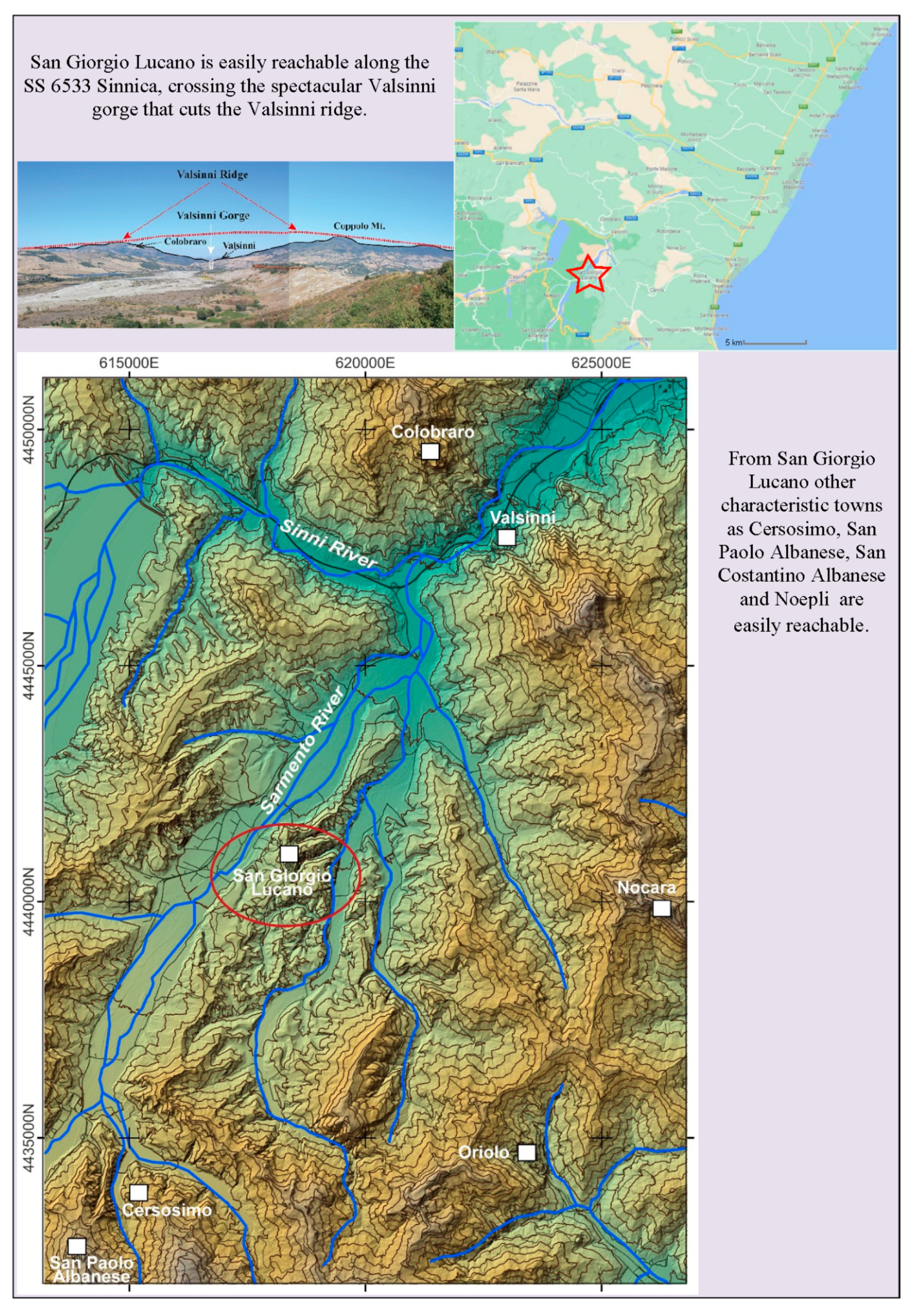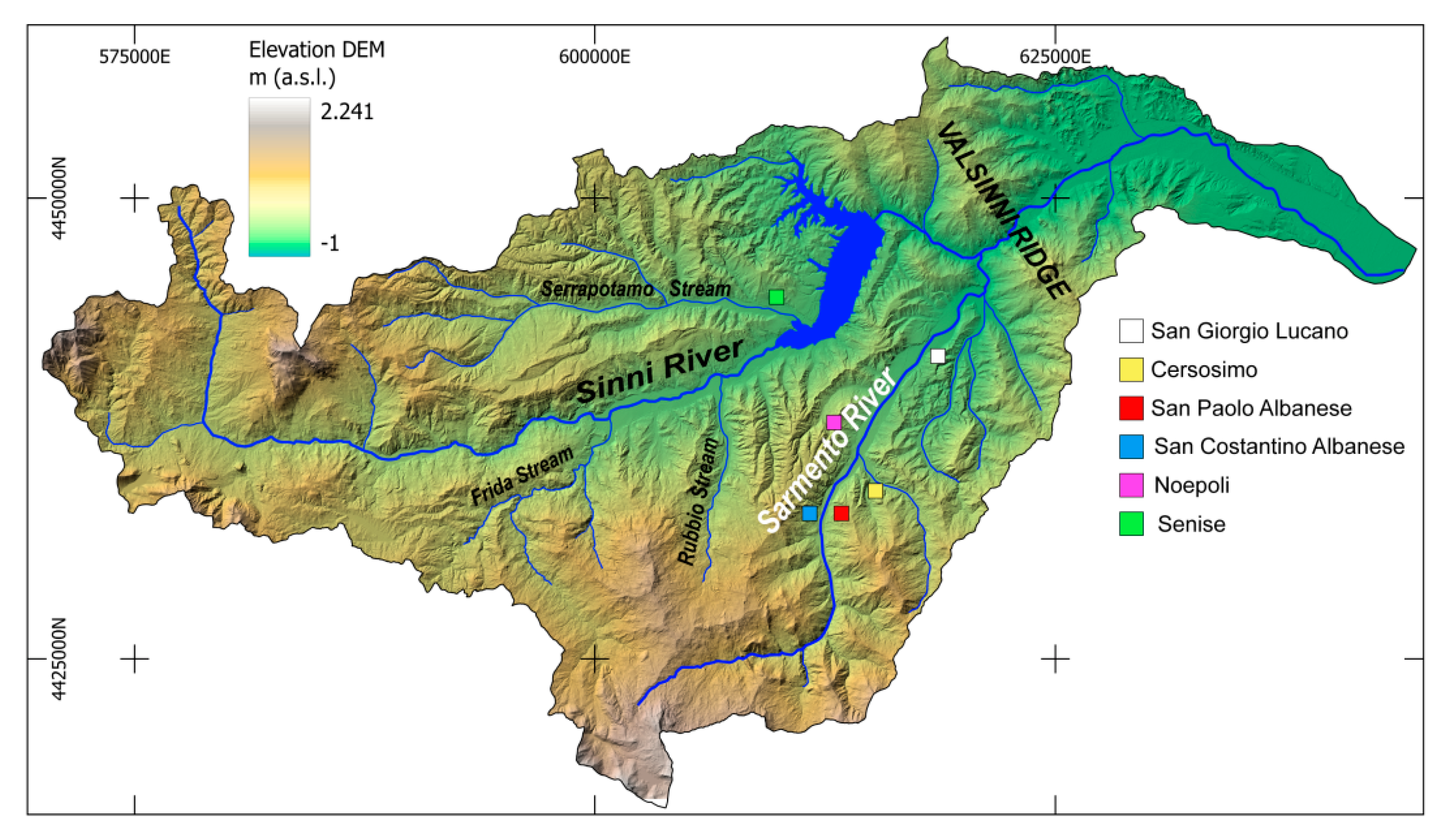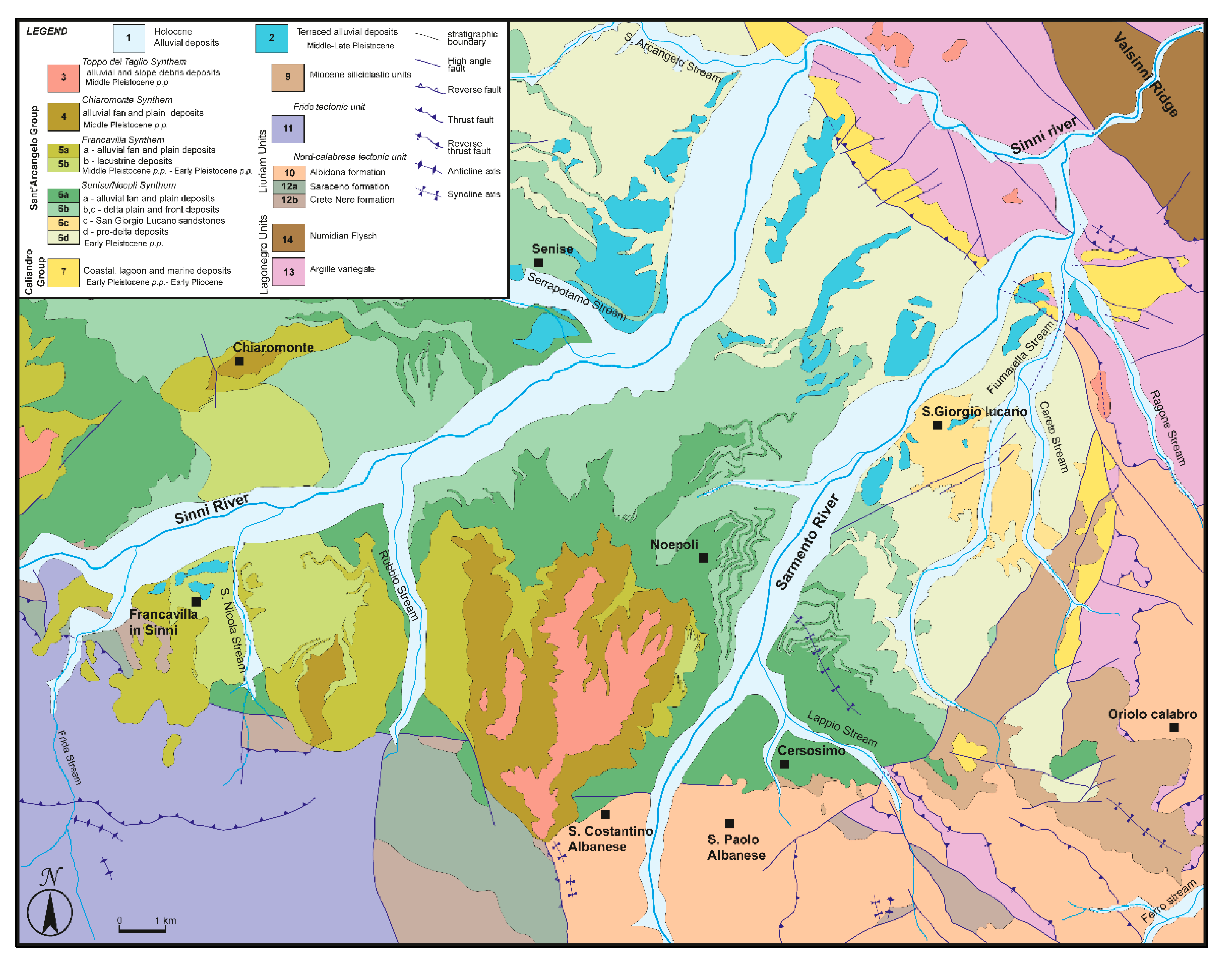Geoheritage Management in Areas with Multicultural Interest Contexts
Abstract
:1. Introduction
2. Methods and Aims
3. General Backgrounds
3.1. Geology
3.2. Geomorphology
3.3. Geoarchaeology
- (a)
- characterized by (i) large flat areas and plateaus, (ii) water availability (in ancient times), (iii) the presence of a waterway whit navigable long stretches;
- (b)
- protected by (iv) a narrow gorge (Valsinni Ridge) and with (v) heights that allowed close control of the territory;
- (c)
- connected with(vi) two important commercial cities located at the mouth of the Sinni River, Siris and Heraclea villages;
- (d)
- located on (vii) the communication route between the Ionian Sea and the Tyrrhenian Sea [63].
4. Results and Discussion: Compound Geomorphosites
4.1. San Giorgio Lucano
- Geo Heritage
- Non Geo Heritage
4.2. Cultural Contexts Schematization
- Educational
- Level I Man-Land use Interplay
- Level III Man-Land use Interplay
- Man—Environment Interplay
- Land—Climate Interplay
- Tourism
- Level I Man- Land use Interplay
- Geology
- Theme-Mineral and Rocks
- Subject-Sedimentary Rock
- Argument-Clastic Rocks, Man/Rocks Interplay
- History
- Theme-Pre-Roman Age, Medieval Age, Mans’s use of land
- Subject-Landscape, Climate, Human activities
- Argument-Man/Rocks Interplay, Fluvial System and Human activities
- Human activities and Climate changes.
- Physical Geography
- Theme–Geosystem
- Subject–Fluvial Geosystem
- Argument–Fluvial Geosystem and Human activities
- Theme–Geomorphic processes
- Subject–Exogenous forces
- Argument–Man as geomorphic agent
- Theme–Climate
- Subject–Climate changes
- Argument–Climate changes and Human activities
4.3. Geoheritage Management
5. Concluding Remarks
Author Contributions
Funding
Institutional Review Board Statement
Informed Consent Statement
Data Availability Statement
Acknowledgments
Conflicts of Interest
Appendix A






References
- Gray, M. Geodiversity: Valuing and Conserving Abiotic Nature, 2nd ed.; Wiley Blackwell: Chichester, UK, 2013; pp. 1–512. [Google Scholar]
- Gray, M. Geodiversity: The backbone of geoheritage and geoconservation. In Geoheritage: Assessment, Protection, and Management; Reynard, E., Brilha, J., Eds.; Elsevier: Amsterdam, The Netherlands, 2018; pp. 13–25. [Google Scholar]
- Reynard, E.; Brilha, J. Geoheritage: A multidisciplinary and applied research topic. In Geoheritage: Assessment, Protection, and Management; Reynard, E., Brilha, J., Eds.; Elsevier: Amsterdam, The Netherlands, 2018; pp. 433–438. [Google Scholar]
- Pescatore, E.; Bentivenga, M.; Giano, S.I.; Siervo, V. Geomorphosites: Versatile Tools in Geoheritage Cultural Dissemination. Geoheritage 2019, 11, 1583–1601. [Google Scholar] [CrossRef]
- Giano, S.I.; Pescatore, E.; Biscione, M.; Masini, N.; Bentivenga, M. Geo- and Archaeo-heritage in the Mount Vulture Area: List, Data Management, Communication, and Dissemination. A Preliminary note. Geoheritage 2022, 14, 10. [Google Scholar] [CrossRef]
- Marsh, G.P. Man and Nature: Physical Geography as Modified by Human Action; C. Scribner: New York, NY, USA, 1864; pp. 1–560. [Google Scholar]
- Stoppani, A. Corso di Geologia; Bernardoni and Brigola eds., Milano, Italy, 1873; pp. 1–713. In Corso di Geologia; Bernardoni and Brigola: Milano, Italy; pp. 1–713.
- Hooke, R. On the history of human as geomorphic agents. Geology 2000, 28, 843–846. [Google Scholar] [CrossRef]
- Panizza, M.; Piacente, S. Geomorfologia Culturale; Pitagora Editrice: Bologna, Italy, 2003; pp. 1–350. [Google Scholar]
- Wilkinson, B.H. Humans as geologic agents: A deep-time perspective. Geology 2005, 33, 161–164. [Google Scholar] [CrossRef]
- Goudie, A. The Human Impact on the Environment, 6th ed.; Blackwell: Oxford, UK, 2007; pp. 1–410. [Google Scholar]
- Crutzen, P.J.; Stoermer, E.F. The “Anthropocene”. Glob. Change Newsl. 2000, 41, 17–18. [Google Scholar]
- Crutzen, P.J. Geology of mankind. Nature 2002, 415, 1–23. [Google Scholar] [CrossRef] [PubMed]
- Zalasiewicz, J.; Williams, M.; Smith, A.G.; Barry, T.L.; Coe, A.L.; Bown, P.R.; Brenchley, P.; Cantrill, D.; Gale, A.; Gibbard, P.; et al. Are we now living in the Anthropocene? GSA Today 2008, 18, 4–8. [Google Scholar] [CrossRef]
- Zalasiewicz, J.; Williams, M.; Steffen, W.; Crutzen, P. The new world of the Anthropocene. Environ. Sci. Technol. 2010, 44, 2228–2231. [Google Scholar] [CrossRef] [PubMed]
- Zalasiewicz, J.; Williams, M.; Fortey, R.; Smith, A.; Tiffany, L.; Barry, T.L.; Coe, A.L.; Bown, P.R.; Rawson, P.F.; Gale, A.; et al. Stratigraphy of the Anthropocene. Phil. Trans. R. Soc. Am. 2011, 369, 1036–1055. [Google Scholar] [CrossRef]
- Price, S.J.; Ford, J.R.; Cooper, A.H.; Neal, C. Humans as major geological and geomorphological agents in the Anthropocene: The significance of artificial ground in Great Britain. Phil. Trans. R. Soc. Am. 2011, 369, 1056–1084. [Google Scholar] [CrossRef] [PubMed]
- Lorant, D. Introduction To Anthropogenic Geomorphology. In Studies on Environmental and Applied Geomorphology; Piacentini, T., Ed.; IntechOpen: London, UK, 2012. [Google Scholar]
- Huckleberry, G. Interdisciplinary and specialized geoarchaeology: A post-Cold War perspective. Geoarchaeology 2000, 15, 523–536. [Google Scholar] [CrossRef]
- Pollard, A.M. (Ed.) Geoarchaeology: Exploration, Environments, Resources; Special Publications; Geological Society: London, UK, 1999; Volume 165, pp. 7–14. [Google Scholar]
- Butzer, K.W. Archaeology as Human Ecology: Method and Theory for a Contextual Approach; Cambridge University Press: Cambridge, UK, 1982; pp. 1–359. [Google Scholar]
- Zvelebil, M.; Green, S.W.; Macklin, M.G. Archaeological landscapes, lithic scatters and human behavior. In Space, Time and Archaeological Landscapes; Rossigno, J., Wandsnider, L.A., Eds.; Plenum: New York, NY, USA, 1992; pp. 193–226. [Google Scholar]
- Wells, L.E. A geomorphological approach to reconstructing archaeological settlement patterns based on surficial artefact distribution. In Earth Sciences and Archaeology; Goldberg, P., Holliday, V.T., Ferring, C.R., Eds.; Kluwer: New York, NY, USA, 2001; pp. 107–141. [Google Scholar]
- Barton, C.M.; Bernabeu, J.; Aura, J.E.; Garcia, O.; La Roca, N. Dynamic landscapes, artefact taphonomy, and landuse modeling in the Western Mediterranean. Geoarchaeology 2002, 17, 155–190. [Google Scholar] [CrossRef]
- Giano, S.I.; Schiattarella, M.; Guarino, P.M. Man-Land interplay in different geological systems In Il Sistema Uomo-Ambiente tra Passato e Presente; Ortolani, F., Livadie, C.A., Eds.; Edipuglia: Ravello, Italy, 1994; ISBN 978-88-7228-197-0. [Google Scholar]
- Patacca, E.; Scandone, P. Geology of the Southern Apennines. Boll. Soc. Geol. It. 2007, 7, 75–119. [Google Scholar]
- Vezzani, L. Il bacino plio-pleistocenico di S. Arcangelo (Lucania). Acc. Gioenia Sci. Nat. Catania 1967, 18, 207–227. [Google Scholar]
- Pieri, P.; Sabato, L.; Loiacono, F.; Marino, M. Il bacino di piggyback di Sant’Arcangelo: Evoluzione tettonico-sedimentaria. Boll. Soc. Geol. It. 1994, 113, 468–481. [Google Scholar]
- Hippolyte, J.C.; Angelier, R.J.; Roure, F.; Casero, P. Piggyback basin development and thrust belt evolution: Structural and paleostress analyses of Plio-Quaternary basins in the Southern Apennines. J. Struct. Geol. 1994, 16, 159–173. [Google Scholar] [CrossRef]
- Gibbard, P.L.; Martin, J.H.; Walker, M.J.C. The Subcommision on Quaternary Stratigraphy, Formal ratification of Quaternary System/Period and the Pleistocene Series/Epoch with a base a 2. 58 Ma. J. Quat. Sci. 2010, 25, 96–102. [Google Scholar] [CrossRef]
- Mostardini, F.; Merlini, S. Appennino centro-meridionale, sezioni geologiche e proposta di modello strutturale. Mem. Soc. Geol. It. 1986, 35, 177–202. [Google Scholar]
- Bigi, G.; Castellarin, A.; Catalano, R.; Coli, M.; Cosentino, D.; Dalpiaz, G.V.; Lentini, F.; Parotto, M.; Patacca, E.; Praturlon, A.; et al. Modello strutturale d’Italia; Consiglio Nazionale delle Ricerche (Progetto Finalizzato Geodinamica): Geodinamica, Italy, 1992. [Google Scholar]
- Beneduce, P.; Giano, S.I. Osservazioni preliminari sull’assetto morfostrutturale dell’edificio vulcanico del Monte Vulture (Basilicata). Il Quaternario 1996, 9, 325–330. [Google Scholar]
- Ciaranfi, N.; Guida, M.; Iaccarino, G.; Pescatore, T.; Pieri, P.; Rapisardi, L.; Ricchetti, G.; Sgrosso, I.; Torre, M.; Tortorici, L.; et al. Elementi sismotettonici dell’Appennino Meridionale. Boll. Soc. Geol. It. 1983, 102, 201–222. [Google Scholar]
- Ortolani, F.; Pagliuca, S.; Pepe, E.; Schiattarella, M.; Toccaceli, R.M. Active tectonics in the Southern Apennines: Relationships between cover geometries and basement structure. A hypothesis for a geodynamic model. IGCP 276 Newsl. 1992, 5, 413–419. [Google Scholar]
- Pescatore, T.; Renda, P.; Schiattarella, M.; Tramutoli, M. Stratigraphic and structural relationships between Meso-Cenozoic Lagonegro basin and coeval carbonate platforms in southern Apennines, Italy. Tectonophysics 1999, 315, 269–286. [Google Scholar] [CrossRef]
- Giano, S.I.; Gioia, D.; Schiattarella, M. Morphotectonic evolution of connected intermontane basins from the southern Apennines, Italy: The legacy of the pre-existing structurally-controlled landscape. Rend. Fis. Acc. Lincei 2014, 25, 241–252. [Google Scholar] [CrossRef]
- Di Leo, P.; Giano, S.I.; Gioia, D.; Mattei, M.; Pescatore, E.; Schiattarella, M. Evoluzione morfotettonica quaternaria del bacino intermontano di Sanza (Appennino meridionale). Il Quat. 2009, 22, 189–206. [Google Scholar]
- Schiattarella, M. Quaternary tectonics of the Pollino Ridge, Calabria-Lucania boundary, Southern Italy. In Continental Transpressional and Transtensional Tectonics; Holdsworth, R.E., Strachan, R.A., Dewey, J.F., Eds.; Geological Society: London, UK, 1998; Volume 135, pp. 341–354. [Google Scholar]
- Bavusi, M.; Chianese, D.; Giano, S.I.; Mucciarelli, M. Multidisciplinary investigations on the Grumentum Roman acqueduct (Basilicata, southern Italy). Ann. Geophyisics 2004, 47, 1791–1801. [Google Scholar]
- Lentini, F. Stratigrafia micropaleontologica dei terreni plio-pleistocenici di S. Arcangelo (Potenza). Acc. Gioenia Sci. Nat. Catania 1968, 19, 255–344. [Google Scholar]
- Lentini, F.; Vezzani, L. Note illustrative del Foglio 506 S.; Arcangelo. I.R.P.I.; CNR: Cosenza, Italiy, 1974. [Google Scholar]
- Caldara, M.; Loiacono, F.; Morlotti, E.; Pieri, P.; Sabato, L. I depositi plio-pleistocenici della parte nord del bacino di Sant’Arcangelo (Appennino lucano): Caratteri geologici e paleoambientali. Mem. Soc. Geol. It. 1988, 41, 391–410. [Google Scholar]
- Casero, P.; Roure, F.; Endignoux, L.; Moretti, I.; Muller, C.; Sage, L.; Vially, R. Neogene geodynamic evolution of the Southern Apennines. Mem. Soc. Geol. It. 1988, 41, 109–120. [Google Scholar]
- Turco, E.; Maresca, R.; Cappadona, P. La tettonica plio-pleistocenica del confine calabro-lucano: Modello cinematico. Mem. Soc. Geol. It. 1990, 45, 519–529. [Google Scholar]
- Zavala, C. Stratigraphy and sedimentary history of the Plio-Pleistocene Sant’Arcangelo Basin, Southern Apennines, Italy. Riv. Ital. Di Paleontol. E Stratigr. 2000, 106, 399–416. [Google Scholar]
- Giannandrea, P.; Loiacono, F. Le successioni alluvionali e lacustri quaternarie affioranti nella media valle del Fiume Sinni (Appennino meridionale, Basilicata). Il Quat. 2003, 16, 257–267. [Google Scholar]
- APAT. Carta Geologica d’Italia Alla Scala 1:50.000 Foglio 506 Sant’Arcangelo. Servizio Geologico d’Italia 2005. Available online: https://www.isprambiente.gov.it/Media/carg/506_SANT_ARCANGELO/Foglio.html (accessed on 20 March 2022).
- ISPRA. Carta Geologica d’Italia Alla Scala 1:50.000 Foglio 522 Senise. Istituto Superiore per la Protezione e la Ricerca Ambientale, Servizio Geologico d’Italia 2011. Available online: https://www.isprambiente.gov.it/Media/carg/522_SENISE/Foglio.html (accessed on 20 March 2022).
- ISPRA. Carta Geologica d’Italia Alla Scala 1:50.000 Foglio 523 Rotondella. Istituto Superiore per la Protezione e la Ricerca Ambientale, Servizio Geologico d’Italia 2012. Available online: https://www.isprambiente.gov.it/Media/carg/523_ROTONDELLA/Foglio.html (accessed on 20 March 2022).
- ISPRA. Carta Geologica d’Italia Alla Scala 1:50.000 Foglio 507 Pisticci. Istituto Superiore per la Protezione e la Ricerca Ambientale, Servizio Geologico d’Italia 2014. Available online: https://www.isprambiente.gov.it/Media/carg/507_PISTICCI/Foglio.html (accessed on 20 March 2022).
- Roure, F.; Casero, P.; Vially, R. Growth processes and melange formation in the southern Apennines accretionary wedge. Earth Planet. Sci. Lett. 1991, 102, 395–412. [Google Scholar] [CrossRef]
- Casciello, E.; Pappone, G.; Zuppetta, A. Plio-Pleistocene tectonic evolution of the western margin of the S. Arcangelo basin (Southern Apennines). Boll. Soc. Geol. It. 2002, 1, 343–352. [Google Scholar]
- Calabrò, R.A.; Feltre, L.; Perotti, C.R. Structural features of the S. Arcangelo piggyback Basin (Southern Apennines, Italy) from seismic data and analogue modelling. Boll. Soc. Geol. It. 2002, 1, 333–341. [Google Scholar]
- Catalano, S.; Monaco, C.; Tortorici, L.; Paltrinieri, W.; Steel, N. Neogene-Quaternary tectonic evolution of the southern Apennines. Tectonics 2004, 23, TC2003. [Google Scholar] [CrossRef]
- Knott, S.D.; Turco, E. Late Cenozoic kinematics of the Calabrian arc, southern Italy. Tectonics 1991, 10, 1164–1172. [Google Scholar] [CrossRef]
- Benvenuti, M.; Bonini, M.; Moratti, G.; Sani, F. Tectonosedimentary evolution of the Plio–Pleistocene Sant’Arcangelo Basin (Southern Apennines, Italy). In Tectonics of the Western Mediterranean and North Africa; Moratti, G., Chalouan, A., Eds.; Geological Society of London: London, UK, 2006; Volume 262, pp. 289–322. [Google Scholar]
- Schiattarella, M.; Giano, S.I.; Gioia, D. Long-term geomorphological evolution of the axial zone of the Campania-Lucania Apennine, Southern Italy. Geol. Carpathica 2017, 68, 57–67. [Google Scholar] [CrossRef] [Green Version]
- Giano, S.I.; Giannandrea, P. Late Pleistocene differential uplift inferred from the analysis of fluvial terraces (southern Apennines, Italy). Geomorphology 2014, 217, 89–105. [Google Scholar] [CrossRef]
- Bocquet-Appel, J.P. When the world’s population took off: The springboard of the Neolithic demographic transition. Science 2011, 333, 560–561. [Google Scholar] [CrossRef]
- AAVV Atti Convegni sulla Magna Grecia dal 1962 al 2015. Available online: http://www.istitutomagnagrecia.it/pubblicazioni/atti-dei-convegni/;https://edipuglia.it/siris-open-access/;QuaderniConsiglioregionaledellaBasilicata.https://www.old.consiglio.basilicata.it/pubblicazioni/main.asp (accessed on 30 March 2022).
- Tagliente, M. Itinerari fluviali e popolamento antico nel mondo indigeno della Basilicata. In Archeologia dell’acqua in Basilicata; Soprintendenza Archeologica della Basilicata e Consiglio Regionale di Basilicata: Potenza, Italy, 1999. [Google Scholar]
- Quilici, L. Dallo Ionio al Tirreno: Il Percorso Della via Istmica Nella Valle del Sinni, Atlante Tematico di Topografia Antica; L’Erma di Bretschneider: Roma, Italy, 2015; pp. 1–240. [Google Scholar]
- Quilici, L.; Quilici Gigli, S. La Carta Archeologica Della Valle del Sinni: Dalle Premesse alla Realizzazione in Carta Archeologica Della Valle del Sinni, Atlante Tematico Di Topografia Antica; L’Erma di Bretschneider: Roma, Italy, 2003; pp. 1–240. [Google Scholar]
- Quilici Gigli, S. Da San Giorgio Lucano a Cersosimo. In Carta Archeologica Della Valle del Sinni: Da Valsinni a san Giorgio Lucano e Cersosimo, Atlante Tematico Di Topografia Antica; Quilici Gigli, S., Ed.; L’Erma di Bretschneider: Roma, Italy, 2003; Volume 2, pp. 147–223. [Google Scholar]
- van Andel, T.H.; Runnels, C.N.; Pope, K.O. Five Thousands Years of Land Use and Abuse in the Southern Argolid, Greece. Hesperia 1986, 55, 103–128. [Google Scholar] [CrossRef]
- Runnels, C.N. Environmental degradation in ancient Greece. Sci. Am. 1995, 272, 96–99. [Google Scholar] [CrossRef]
- Corti, G.; Cocco, S.; Brecciaroli, G.; Agnelli, A.; Seddaiu, G. Italian Soil Management from Antiquity to Nowadays. In The Soils of Italy; World Soils Book Series; Costantini, E.A.C., Dazzi, C., Eds.; Springer Science: Dordrecht, The Netherlands, 2013. [Google Scholar] [CrossRef]
- Neboit, R. Un exemple de morphogenese accélérée dans l’antiquite: Les vallées du Basento et du Cavone en Lucanie (Italie). Méditerranée Rev. Geogr. Des Pays Méditerranées 1977, 31, 39–50. [Google Scholar] [CrossRef]
- Neboit, R. Morphogenèse et occupation humaine dans l’Antiquité (Morphogenesis and human settlement during classical antiquity). Bull. De L’association De Géographes Français 1980, 466–467, 21–27. [Google Scholar] [CrossRef]
- Neboit, R. L’homme et l’érosion; Faculté des lettres et sciences humaines de l’Université de Clermont-Ferrand II: Clermont-Ferrand, France, 1984; pp. 1–183. [Google Scholar]
- Bruckner, H. Man’s Impact on the Evolution of the Physical Environment in the Mediterranean Region in Historical Times. GeoJournal 1986, 13, 7–17. [Google Scholar] [CrossRef]
- Boenzi, F.; Caldara, M.; Capolongo, D.; Dellino, P.; Piccarreta, M.; Simone, O. Late Pleistocene–Holocene landscape evolution in Fossa Bradanica, Basilicata (southern Italy). Geomorphology 2008, 102, 297–306. [Google Scholar] [CrossRef]
- Piccarreta, M.; Caldara, M.; Capolongo, D.; Boenzi, F. Holocene geomorphic activity related to climatic change and human impact in Basilicata, Southern Italy. Geomorphology 2011, 128, 137–147. [Google Scholar] [CrossRef]
- Bentivenga, M.; Giano, S.I.; Piccarreta, M. Recent increase of flood frequency in the Ionian belt of Basilicata region, Southern Italy: Human or climatic changes? Water 2020, 12, 2062. [Google Scholar] [CrossRef]
- Bottini, A. (Ed.) La panoplia lucana del Museo provinciale di Potenza. In Mélanges de l’École Française de Rome; Bottini: Antiquité, Italy, 1989; Volume 101, pp. 699–715. [Google Scholar]
- Bentivenga, M.; Capece, A.; Guglielmi, P.; Martorano, S.; Napoleone, D.; Palladino, G.; Luca, V.G. The San Giorgio Lucano Anthropic Cave Complex (Basilicata, Southern Italy): A Geosite to Protect and Enhance. Geoheritage 2019, 11, 1509–1519. [Google Scholar] [CrossRef]
- Guillou, A. Culture and Society in Byzantine Italy, 6th–11th Centuries; Variorum Collected Studies Series; Khan Academy: London, UK, 1978; ISBN 978-0860780212. [Google Scholar]
- Consentino, S. Storia dell’Italia Bizantina (VI-XI Secolo); Da Giustiniano ai Normanni; Bononia University Press: Bologna, Italy, 2008; pp. 1–528. [Google Scholar]












Publisher’s Note: MDPI stays neutral with regard to jurisdictional claims in published maps and institutional affiliations. |
© 2022 by the authors. Licensee MDPI, Basel, Switzerland. This article is an open access article distributed under the terms and conditions of the Creative Commons Attribution (CC BY) license (https://creativecommons.org/licenses/by/4.0/).
Share and Cite
Pescatore, E.; Bentivenga, M.; Giano, S.I. Geoheritage Management in Areas with Multicultural Interest Contexts. Sustainability 2022, 14, 15911. https://doi.org/10.3390/su142315911
Pescatore E, Bentivenga M, Giano SI. Geoheritage Management in Areas with Multicultural Interest Contexts. Sustainability. 2022; 14(23):15911. https://doi.org/10.3390/su142315911
Chicago/Turabian StylePescatore, Eva, Mario Bentivenga, and Salvatore Ivo Giano. 2022. "Geoheritage Management in Areas with Multicultural Interest Contexts" Sustainability 14, no. 23: 15911. https://doi.org/10.3390/su142315911
APA StylePescatore, E., Bentivenga, M., & Giano, S. I. (2022). Geoheritage Management in Areas with Multicultural Interest Contexts. Sustainability, 14(23), 15911. https://doi.org/10.3390/su142315911







